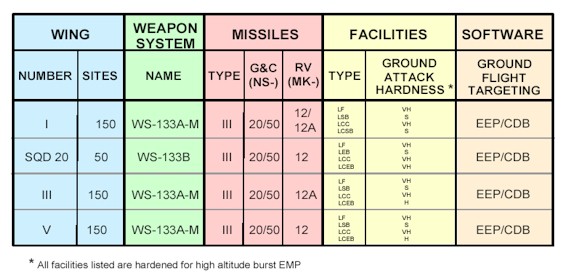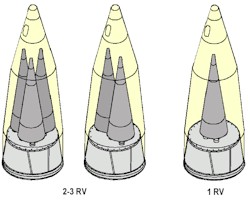![]()
To MIRV or Not to MIRV
The Pentagon confirmed in 2003 and 2004 that it is considering retaining multiple warheads on its 500 Minuteman III ICBMs rather than downloading each missile to single-warhead configuration as planned under START II Treaty only a couple of years ago. The initiative follows the signing of the Moscow Treaty with Russia in 2002 which nullified the START II agreement.
According to a report in Air Force Magazine in October 2003, Maj. Gen. Robert L. Smolen, USAF’s director of nuclear and counterproliferation operations at the Pentagon, stated that up to 800 warheads would be carried on the force. Follow-up conversations with military officials revealed that the Air Force dismissed the Air Force Magazine report saying that Maj. Gen. Smolen had been misquoted and that decision had not yet been made. Instead the Air Force provided the following transcript for the record:
Brig Gen Robert L. Smolen, Air Force Director of Nuclear & Counterproliferation, and Adam Hebert, Air Force Magazine, July 14, 2003:
HEBERT: The Minuteman fleet itself is in a split configuration at the moment where the Warren missiles have one warhead and the other two wings have three warheads.
SMOLEN: If I could comment on the warhead piece, we cannot confirm or deny the amounts of warheads on the missiles. We could say a Minuteman missile can carry up to a certain amount, but when you say “up to,” that means it could be one or it could be more. So the blend of missiles warheads will largely be determined by the targeting requirements that were given by Strategic Command. The targets … where the targets are will have a factor on which missiles at what location might have one or more warhead. So I don’t think it’s … certainly it has one, but it could have three, it could have two, it could have one.
HEBERT: The way I understand the situation at Warren, though, is that because of START obligations those are now up to one warhead missiles.
SMOLEN: According to the way we’re looking at that, we’re looking at eventually of 500 missiles that could be uploaded to as many as 800 warheads. So somewhere in that mix of 500 is 800. And it could be one on some, two on another, three on another.
Source: Obtained by Hans M. Kristensen from USAF, October 1, 2003.
The Minuteman III was initially designed to carry two or three 170 kilotons Mk-12/W62 reentry vehicles (RV). In the late 1970s, 300 of the original 550 missiles were modified to accommodate the more powerful Mk-12A/W78 RV with a yield of 335 kilotons. The START II Treaty signed in 1993 banned multiple warheads on ICBMs, so in preparation for the treaty entering into force in 2003 (later delayed till 2007), the Air Force between 1992 and 2001 added the capability to the Minuteman III to also be able to carry a single RV (see figure 1).
|
In 2001, the Air Force announced that it
had downloaded 150 Minuteman III missiles at Warren Air Force Base (AFB) to
single-warhead configuration. The move was necessary to bring U.S.
accountable warheads in compliance with the START I Treaty which entered
into effect at the same time. As recent as in June 2001, the Air Force budget still described "downloading of the Minuteman force to single RV configuration," but the language disappeared from the Air Force budget submitted by the Bush administration. |
|
The force of 500 Minuteman IIIs is deployed at three bases: Malmstrom AFB in Montana, Warren AFB in Wyoming, and Minot AFB in North Dakota. The warhead loading on individual warheads may vary depending on assigned mission, but Air Force documents describe that the two types of warheads are deployed at the following bases: the Mk-12/W62 at Malmstrom AFB and Warren AFB, and the Mk-12A/W78 at Malmstrom AFB (Squadron 20) and Minot AFB (see Figure 2).

Fig 2: Minuteman Weapon System Configuration (as
of April 2001)
Beginning in 2006, Mk-21/W87 RVs from the Peacekeeper missile currently being phased out, will be transferred onto part of the Minuteman IIIs under the Safety Enhanced Reentry Vehicle (SERV) program to replace the remaining 300 Mk-12/W62 on 200+ Minuteman IIIs at Warren AFB and Malmstrom AFB. The W62 is scheduled to be scrapped in 2009. The SERV program will provide those Minuteman IIIs with a capability to carry one or two Mk-21/W87s each, but apparently not three. The remaining approximately 300 missiles will continue to carry up to three Mk-12A/W78 RVs each. The W78 currently on the Minuteman III has a higher yield than the W87 (335 vs. 300 kilotons, respectively) on the Peacekeeper, which is why some W78s will be retained on the force.
Unlike the W87, however, the older W78 is not equipped with important safety features such as Insensitive Explosives and Command Disable. The latter is an inertial nonviolent code-activated disabling device which destroys critical warhead components, rendering the warhead useless in case of unauthorized tampering. In addition to adding such safety features into at least a portion of the future Minuteman III force, the decision to transfer W87 onto the missile is based on several features that will improve the targeting capabilities of the weapon:
-
* more fuzing options which will allow for greater targeting flexibility;
-
* the most accurate reentry vehicle available which provide a greater probability of damage.
The final warhead breakdown under the Air Force's new plan is a closely guarded secret, but with an overall loading of 800 warheads and the current configuration, an estimate can be made of approximately 300 Mk-21/W87s on 200 missiles at Warren AFB and Malmstrom AFB, and 500 Mk-12A/W78s on 300 missiles at Minot AFB and Malmstrom AFB. A decision to keep the extra 300 warheads in storage would likely mean fewer W78s deployed on the alert force.
The decision to retain multiple warheads on the ICBM force and the consideration to keep up to 800 warheads on the missiles suggest that U.S. nuclear planning is still strongly tied to the composition of Russian nuclear forces. It is unlikely that 300 new targets have suddenly appeared somewhere in the world, so the move in all likelihood is a reaction to Russia's decision following the Moscow Agreement to retain SS-18 and SS-19 missiles with multiple warheads, and a need on the part of U.S. nuclear planners to continue to target those silos even with the retirement of the Peacekeeper.
In other words, in stark contrast with the description by Bush administration officials of the Nuclear Posture Review representing a new partnership with Russia and an end to the balance of terror, U.S. nuclear planning appears to remain firmly centered on decapitating Russian nuclear forces.
©
Hans M. Kristensen | www.nukestrat.com | 2004
